ABSTRACT
The boundary between the New Zealand Porangan and Bortonian stages (Middle Eocene) is no longer exposed in the original Porangan type section, and was never documented from the original Bortonian type section. Although the stage boundary is inferred to exist at Hampden Beach, North Otago, a site that has been the Bortonian reference section for many years, it is poorly exposed. Consequently, this paper proposes a new reference section for the base of the Bortonian Stage within an approximately 30 m-thick outcrop of Wanstead Formation exposed in Tahuokaretu Stream, ∼3 km east of Weber, Tararua District (southern Hawke’s Bay), New Zealand. Twenty-four samples from four collections have been analysed in support of this proposal. Fossil foraminifera and dinoflagellate assemblages are described. Following current practice, the base of the Bortonian Stage is placed at the stratigraphically lowest sample having the planktic foraminifera, Globigerinatheka index. The underlying Porangan is identified by the benthic foraminifera, Elphidium saginatum. There is no significant change in the paleoenvironment at the Porangan-Bortonian boundary, indicating the boundary is not affected by facies change.
Introduction
To a significant extent, the New Zealand fossil biota is highly endemic. One response to this has been the development of an independent regional timescale of epochs/series and ages/stages (Cooper Citation2004; Hollis et al. Citation2010; Raine et al. Citation2015; also see the discussion in Gradstein et al. Citation2012, p. 19–20). The Cenozoic divisions of the New Zealand Geological Timescale are almost all defined by the first or last appearances of foraminifera species, a schema largely established in the early 1940s by Harold Finlay, which has remained remarkably stable for more than 60 years (Hayward and Scott Citation2013).
The Porangan and overlying Bortonian stages, discussed herein, are New Zealand geological time units of age/stage rank, which correlate approximately with the middle Eocene interval from middle Lutetian to middle Bartonian of the international timescale. The Porangan-Bortonian stage boundary is also the Dannevirke-Arnold series boundary.
The Porangan Stage was erected by Finlay and Marwick (Citation1947, p. 232) who nominated a type section in Te Uri Stream, Central Hawke’s Bay (), and used foraminifera to define the stage as
that part of the section marked (primarily) by the presence of Elphidium saginatum Fin. The lower limit is marked also by the lowest occurrence of Siphotextularia acutangula Fin., Globigerinella iota Fin., and Cassidulina subglobosa Brady. … The upper limit is marked by the highest occurrence of Bolivinopsis compta Fin. and Vulvulina zespinosa Fin.
Figure 1. Map of New Zealand showing locations referenced in the text: Te Uri Stream, Tawanui, Tahuokaretu Stream, Bortons and Hampden Beach sections, identified by red circles. The inset map grid is 10,000 m New Zealand Transverse Mercator (NZTM); it has a true north orientation.
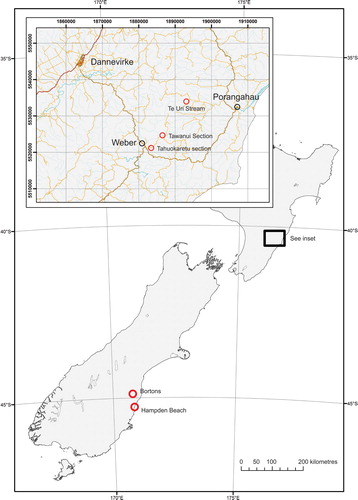
Following the guidelines of the International Commission on Stratigraphy (Remane et al. Citation1996), however, we regard the top of the Porangan Stage as being implicitly defined by the base of the immediately overlying Bortonian Stage, and not requiring separate definition.
The unit that subsequently became the Bortonian Stage was established by Park (Citation1918) based upon a characteristic molluscan assemblage from the lower part of the (now disused) Waiarekan Stage of Thomson (Citation1916). Two collections from the Black Point coal mine, near Bortons in the Waitaki Valley (), were briefly discussed and a species list provided by Park (Citation1918, p. 34). Over time, various researchers (e.g. Allan Citation1933; Finlay and Marwick Citation1940) suggested definitions for the base of the Bortonian. The current definition was proposed by Morgans et al. (Citation2004, p. 148) who note that the ‘most useful foraminiferal event for defining the stage base is the lowest occurrence of the planktic foraminifer Globigerapsis [now Globigerinatheka] index (abundant, large, and with multiple apertures)’. This is the criterion for recognising the boundary adopted herein. The age of this event, given as 42.6 Ma by Raine et al. (Citation2015), is based on the FAD of Globigerinatheka index near the C20n/C20r chron boundary in ODP Hole 689B (Berggren et al. Citation1995; also cited in Gradstein et al. Citation2012, p. 1096).
At Te Uri Stream, the Porangan Stage is overlain by some 160 m of Bortonian sedimentary rock. However, this Bortonian succession has not been given serious attention hitherto and is unlikely to receive it now: Te Uri Stream has aggraded since the 1940s and small, isolated outcrops are all that presently remain of the Porangan type section and overlying Bortonian rocks. No contacts between these two units are known from Te Uri Stream today.
The section at Bortons is poorly exposed and poorly fossiliferous (Morgans et al. Citation2004, p. 149). Consequently, an alternative reference sequence starting at Park Gulch, 560 m south of the southern bank of Kakaho Creek, Hampden Beach, and encompassing most of the Hampden Formation has long been used instead (Finlay and Marwick Citation1940; Cameron and Waghorn Citation1985; Hornibrook et al. Citation1989; Morgans et al. Citation2004). Here, greensands at the base of the Hampden Formation were reported to contain a sparse Porangan microfauna (Hornibrook et al. Citation1989) and a possible Porangan microflora (Wilson Citation1985) below well-established Bortonian rocks containing Globigerinatheka index, suggesting that a Porangan-Bortonian stage boundary may be present.
Studies of later collections from Park Gulch (Morgans Citation2009) identified a sequence of three samples at 10 cm spacing from an interval usually obscured by beach sands: the three samples are recorded in the New Zealand Fossil Record File under the accession numbers J42/f488 and J42/f489 (both Porangan) and J42/f301 in which the FAD of Globigerinatheka index occurs, identifying the base of the Bortonian Stage. On this basis, Morgans (Citation2009) formally proposed the Park Gulch section as the boundary stratotype section and point (SSP) for the base of the Bortonian, ‘despite the condensed basal greensand and its scarcity of foraminifers’ (p. 296).
In summary, the base of the Bortonian Stage – that is, the boundary between the Porangan and Bortonian stages – is no longer exposed in the original Porangan type section, and has never been documented from the original Bortonian type section. Although rocks spanning the boundary do exist at Hampden, North Otago, the inferred boundary occurs in a highly condensed interval and is usually obscured by beach sands.
Consequently, this paper proposes the adoption of a new reference section for the base of the Bortonian within an approximately 30 m-thick section of Wanstead Formation exposed in the south bank of Tahuokaretu Stream, approximately 3 km east of Weber, Tararua District (). Twenty-four samples have been analysed and incorporated into two columns in support of this proposal. The key Porangan benthic foraminifera, Elphidium saginatum, is recorded from most lower samples whereas the planktic species Globigerinatheka index occurs in the higher samples. The biostratigraphic ranges of the two taxa do not overlap. The base of the Bortonian Stage is placed at the lowest sample having Globigerinatheka index. The occurrence of Acarinina primitiva (Waipawan-Bortonian) in all samples indicates the absence of any post-Bortonian samples from the suite.
Figure 2. Location map for Tahuokaretu section, Tahuokaretu Stream, Weber (abstracted from NZ Topo50 map series, sheet BM37, Weber). The grid lines (NZTM) are aligned to true north and spaced at 1 km intervals; the section is located on the south bank of Tahuokaretu Stream, directly opposite a small, unnamed tributary entering from the north (red circle).
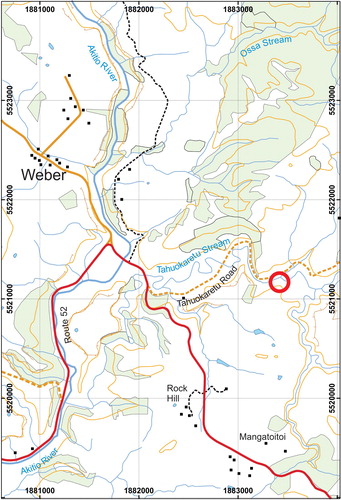
Figure 3. Photograph looking southwards towards the main Tahuokaretu section exposure (base at NZTM 1883412.9 5521194.0); Tahuokaretu Stream flowing east to west (left to right) in the foreground. The ‘western’ section is the near vertical transect up the western edge of the main exposure. The ‘eastern’ section runs from the base of the western section, eastwards across the base of the exposure, at high-water level, and then up the poorly exposed hillside to the east. The approximate positions of two spot samples not on the measured transects are indicated by yellow circles.
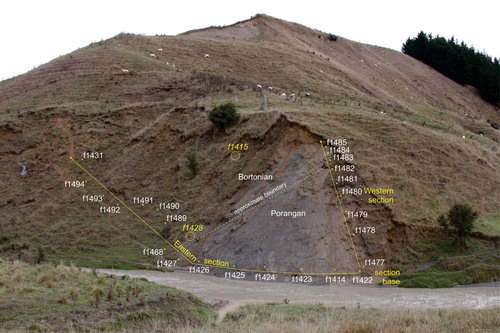
Material and methods
Location
Tahuokaretu Stream flows westward from the core of the Akitio Syncline through undifferentiated late-middle Miocene sedimentary rocks, Ihungia Formation (Early Miocene), Weber Formation (Late Eocene–Oligocene), Wanstead Formation (Paleocene–Eocene) and Whangai Formation (Late Cretaceous–Paleocene) where it meets the Akitio River just south-east of Weber township (). A section approximately 30 m thick, comprising massive to very poorly bedded, light-grey, frittery calcareous mudstone of the Wanstead Formation, crops out in privately owned farmland on the south-eastern side of the stream (). The exposure appears uniform, with no obvious sedimentary breaks, and is assumed to be conformable. The exposure has changed little over 30 years. Stock movement, weather, and the moderate steepness of the slope have kept vegetation on the main exposure at bay. Along the eastern side of the exposure, a shallow trench exposes the mudstone.
The base of the section is located at 40° 24.691’ S 176° 20.414’ E ± 4 m (NZTM 1883412.9 5521194.0; NZMS 260 U24/9341-8291) (). It is readily accessed from Tahuokaretu Road, 1.5 km east from its intersection with Route 52, barely 25 metres across a fence and the stream to the outcrop. Permission to enter the section should be sought from Mangatoitoi Farm.
A general history of Tahuokaretu Road and the immediate area is provided in Morgans (Citation2002).
Collection history
The section was first examined in 1987 by David Francis and Hugh Morgans. One sample, U24/f0376, was collected and dated as Porangan. During January 2014 two further samples, U24/f1414 (Porangan Age) and f1415 (Bortonian Age), were collected by Morgans, establishing that a Porangan-Bortonian boundary was present in the section.
Subsequently, in April 2014, the present authors made a third collection of 10 samples (U24/f1422 to 1431) across the base of the main exposure, to more precisely locate the boundary and gather a larger sample suite for more detailed study. Analysis of this collection established the location of the stage boundary to within 2 m, just above stream level at the eastern edge of the large primary outcrop.
A fourth suite of samples was collected from a near vertical transect up the western edge of the exposure, and from the Bortonian rocks extending up-section from the eastern edge of the outcrop (Clowes et al. Citation2016).
Stratigraphy
Those samples form the basis of the two (eastern and western) subsections used in the present study (). The base of each section is approximately coincident, just above stream level at the western edge of the main exposure. The Porangan-Bortonian boundary which was separately identified in each section provides a second line of correlation and indicates the line of dip in the otherwise massive outcrop ().
Figure 4. Stratigraphic columns for Tahuokaretu section, showing the division of samples, identified by their Fossil Record Numbers (FRN) between eastern and western sub-sections. Spot samples are not indicated. Vertical scale (in metres) is the same for both columns.
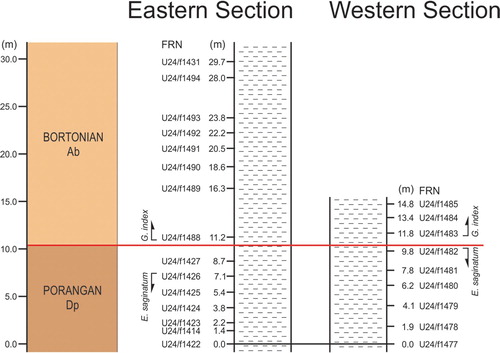
Two spot samples examined during earlier reconnaissance work, U24/f1415 and U24/f1428 (), produced well-preserved faunas and were therefore also included in the present study.
Sample processing
Owing to the massive nature of the sediment and the need to get representative samples, a moderately constant sampling interval was maintained.
Processing of foraminiferal and palynological preparations followed standard techniques. To obtain foraminiferal residues, >300 g of material was dried at 40°C, weighed, and soaked in water for a day, washed over a 75 μm screen, dried at 40°C, and the residue weighed. Residues were split with a Carpco microsplitter and one half retained for future census work. The remaining material was exhaustively picked, in many cases requiring two faunal slides, to compile full faunal lists, and to recover planktonic assemblages.
Splits of about 30 g were taken for palynological processing. Carbonates were first removed with hot 10% hydrochloric acid. Silicates were then digested in ∼50% hydrofluoric acid, followed by a second hot 10% hydrochloric acid wash to remove fluorosilicate reaction products. The majority of the samples were oxidised in concentrated (70%) nitric acid followed by neutralisation of humic acids in 5% ammonium hydroxide. In all cases, the organic fraction was density separated by floatation in a solution of sodium polytungstate with a specific gravity of 2.0. Finally, the light fraction was sieved over a 6 µm mesh and mounted under glass coverslips in glycerine jelly.
Paleontology
Full species lists are entered in the New Zealand Fossil Record File (https://fred.org.nz). Occurrence data for all common or stratigraphically important taxa are shown in a table (Supplementary Data).
Foraminifera
Eastern section
The eastern section is represented by a suite of 15 samples which contain well-preserved and diverse planktic and benthic foraminiferal assemblages, typical of the middle Eocene part of the Wanstead Formation seen around the Hawke’s Bay region (Hornibrook et al. Citation1989). Twenty-six planktic taxa have been identified by the authors, and although we have yet to fully examine the benthic fauna, it is estimated to contain over 200 species.
The lowest six samples, f1414 and f1422–f1426, contain the benthic foraminifera Elphidium saginatum (D-E), an index species for the Porangan Stage. Elphidium saginatum is absent from the next highest sample, f1427. However, Globigerinatheka index does not first appear until sample f1488, so f1427 is included in the Porangan Stage.
Figure 5. Representative Foraminifera from Tahuokaretu section, SEM micrographs. U24/fxxxx = sample (see and ). FPxxxx = catalogue number of specimen in foraminiferal collections at GNS Science, Lower Hutt. Scale bar = 100 µm in all images. A) Globigerinatheka index (Finlay); sample U24/f1428 (Tahuokaretu section, Bortonian); figured specimen reference FP5569; apertural view. B) Globigerinatheka index (Finlay); sample U24/f1428 (Tahuokaretu section, Bortonian); figured specimen reference FP5570; spiral view. C) Globigerinatheka index (Finlay); sample U24/f1428 (Tahuokaretu section, Bortonian); figured specimen reference FP5571; side view. D) Elphidium saginatum Finlay; sample U24/f1423 (Tahuokaretu section, late Porangan); figured specimen reference FP5572; side/spiral view. E) Elphidium saginatum Finlay; sample U24/f1423 (Tahuokaretu section, late Porangan); figured specimen reference FP5573; front/apertural view. F) Aragonia zelandica Finlay; sample U24/f1431 (Tahuokaretu section, Bortonian); figured specimen reference FP5574. G) Acarinina primitiva (Finlay); sample U24/f1431 (Tahuokaretu section, Bortonian); figured specimen reference FP5575; oblique side/apertural view. H) Acarinina primitiva (Finlay); sample U24/ f1431 (Tahuokaretu section, Bortonian); figured specimen reference FP5576; spiral view. I) Bulimina bortonica Finlay; sample U24/ f1431 (Tahuokaretu section, Bortonian); figured specimen reference FP5577. J) Euuvigerina wanzea (Finlay); sample U24/ f1415 (Tahuokaretu section, Bortonian); figured specimen reference FP5578. K) Euuvigerina bortotara (Finlay); sample U24/ f1431 (Tahuokaretu section, Bortonian); figured specimen reference FP5579. L) Buliminella browni Finlay; sample U24/ f1428 (Tahuokaretu section, Bortonian); figured specimen reference FP5580.
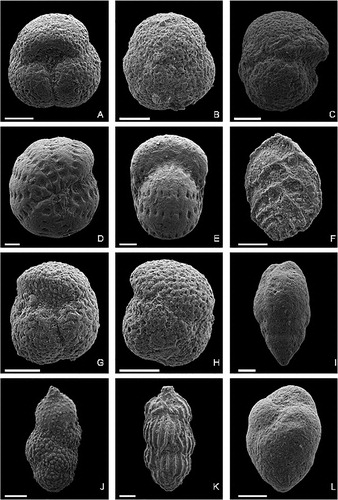
The uppermost eight samples, f1488-f1494 and f1431, lie above the FAD of Globigerinatheka index and are assigned to the Bortonian Stage. This interpretation is supported by the presence of Acarinina primitiva (Dw–Ab) and the benthic Bulimina bortonica (Dp–Ab) based on data from GNS files and Morgans Citation2009 (p. 299, 305). All are easily identified, are relatively common in the samples examined, and are ubiquitous in Bortonian material from the East Coast Basin (pers. obs.) Other planktic foraminifera making first appearances in the Bortonian, here, include Hantkenina australis, Morozovelloides crassatus, Turborotalia frontosa, Turborotalia possagnoensis, and Turborotalia increbescens. These have rather sporadic occurrences limiting their biostratigraphic utility.
Western section
The western section comprises nine samples collected from a near-vertical transect up the western edge of the main exposure.
The lower six samples (U24/f1477 to f1482) are below the FAD of Globigerinatheka index and are of Porangan Age. The Porangan index fossil, Elphidium saginatum, was recovered from five of the six samples, and was absent from sample U24/f1480. The abundance of Elphidium saginatum, from moderately exhaustive qualitative picks on material >150 µm, ranges from greater than 50 specimens recovered (moderately abundant), to fewer than 5 specimens (rare). Typical middle Eocene planktic faunas were recovered including Acarinina primitiva, Acarinina collactea, Subbotina angiporoides minima, and Subbotina corpulenta among others.
The three overlying samples (U24/f1483 to f1485) lie above the FAD of Globigerinatheka index (Ab–Ar), and are assigned a Bortonian age. This interpretation is supported by the presence of Acarinina primitiva (Dw–Ab), Bulimina bortonica (Dp–Ab) and Buliminella browni (Dw–Ab). The absence of Euuvigerina wanzea and Euuvigerina bortotara suggests a position low in the Bortonian.
Spot samples
U24/f1415 was collected from approximately 4 m east of the top sample in the western transect (f1485). Its approximate position is indicated on , and it is apparent that this sample lies closely above the top of the western section. The presence of Globigerinatheka index, Acarinina primitiva, and Euuvigerina wanzea indicates a Bortonian age, consistent with early Bortonian.
U24/f1428 was collected from the exposure above f1426, relatively close to the stage boundary (). The presence of Globigerinatheka index indicates it is Bortonian.
Depositional environment
The horizontal eastern section which trends northeast to southwest (sample U24/f1422 to f1427 plus sample U24/1431; and ) was examined for foraminiferal paleodepth indicators. The residues are dominated by radiolarians and broken agglutinated foraminiferal debris. Whole agglutinated specimens are common, but never dominate the benthic assemblages. Ostracods and fish teeth are minor components of the residues. The benthic foraminiferal faunas from this suite remain broadly similar through the Porangan to Bortonian transition, and exhibit no distinctive changes in paleodepth throughout the sampled interval.
The agglutinated benthic foraminifera are dominated by large elongate forms, mainly Bathysiphon spp. and Hyperammina spp., and large Cyclammina, Ammodiscus and Haplophragmoides species. The deep-water benthics include the agglutinates Karreriella novozealandica, Karreriella bradyi, Karreriella chilostoma, Vulvulina bortonica, Schenckiella weymouthi, Hyperammina, Glomospira charoides, and the calcareous taxa Anomalina visenda, Nuttallides truempyi, Cibicides tholus, Cibicides parki, Stilostomella spp., Pleurostomella spp., Nodosarella spp., Aragonia zelandica and Bulimina pahiensis. These taxa have paleodepths ranging from deep upper bathyal (400–600 m) to lower bathyal (>1000 m), and the depths are most likely to be deep middle bathyal (800–1000 m) or as deep as lower bathyal (>1000 m) (Tjalsma et al. Citation1983; Hayward Citation1986; Morkhoven et al. Citation1986).
The number of planktics as a percentage of the total foraminiferal abundance (planktic faunal abundance) is generally 75% to 90%, although it does drop to 50% and 60% for two samples. This abundance implies that a sub-oceanic to near open oceanic water-mass overlay the site of deposition.
Marine Palynomorphs
Relatively little has been published on New Zealand Porangan dinoflagellate assemblages. Wilson’s (Citation1988) study of the Waipawa section included a single Porangan sample, and Clowes (Citation2009) described the assemblages recovered from three Porangan samples collected from Te Uri Stream. Descriptions of Bortonian dinoflagellate assemblages are more numerous and include Wilson (Citation1982, Citation1985), Clowes and Wilson (Citation2006), and Clowes (Citation2009).
The present samples from Tahuokaretu Stream provide us with the first Porangan dinoflagellate assemblages for which the stratigraphic position is well-constrained to better than stage level, and also our most highly resolved succession across the boundary into the lowermost Bortonian Stage. Overall, the Tahuokaretu succession comprises common taxa which extend through all or most of the section (Paucilobimorpha spp., Cerodinium medcalfii, Achilleodinium n.sp., Areosphaeridium dictyostilum, Impagidinium maculatum, several Pyxidinopsis spp.), plus a group of less-common taxa which appear sporadically throughout their ranges (). Notably absent are several taxa commonly cited as being characteristic of this interval (e.g. in Cooper Citation2004) such as Deflandrea convexa and Wilsonidium echinosuturatum. Overall, dinoflagellate diversity generally increases very slightly up-section.
Figure 6. Representative acritarch and dinoflagellate taxa from the Porangan and early Bortonian stages of New Zealand, including Tahuokaretu section. Scale bars are 20 µm in images A and B; 50 μm in images C to L. A) Paucilobimorpha spinigera (de Coninck 1969) Prössl 1994; sample J42/f303 (Hampden Beach section, Bortonian), slide L23133/SM5405; specimen measures 23 × 15 µm. B) Paucilobimorpha tricornus (Marshall & Partridge 1988) n. comb.; sample U24/f419 (Te Uri Stream section, middle? Porangan), slide L23127/SM5396; specimen measures 20 × 20 µm. (Basonym = Tritonites tricornus Marshall & Partridge 1988, p. 245-247, fig. 6A-U). C) Cerodinium medcalfii Stover 1974; sample U24/f1414 (Tahuokaretu section, late Porangan), slide L27695/SM5144; specimen measures 134 × 70 μm. D) Deflandrea convexa Wilson Citation1988; sample U24/f0418 (Te Uri Stream section, middle? Porangan), slide L23126/SM5429; specimen measures 97 × 80 µm. E) Wilsonidium echinosuturatum (Wilson 1967) Williams et al. 2015; sample V22/f7401 (Waipawa/Windsor Road section, early Porangan), slide L12121/SM263; specimen measures 152 × 137 µm (topotype but not a paratype as stated in Wilson Citation1988, caption to pl. 25, fig. 3). F) Wilsonidium lineidentatum (Deflandre & Cookson 1955) Williams et al. 2015; sample J42/f055 (Hampden Beach section, Bortonian), slide L9212/SM2878; specimen measures 125 × 105 µm. G) Impagidinium maculatum (Cookson & Eisenack 1961) Stover & Evitt 1978; sample U24/f1414 (Tahuokaretu section, late Porangan), slide L27695/SM5156; specimen measures 53 × 54 µm. H) Achilleodinium n. sp.; sample I43/f0090 (88.60 m – 88.63 m, Puketeraki No. 2 core, Abbotsford, Bortonian), slide L16338/SM4830; specimen measures 126 × 112 µm. I) Hystrichosphaeridium tubiferum (Ehrenberg 1838) Deflandre 1937; sample U24/f1414 (Tahuokaretu section, late Porangan), slide L27695/SM5159; specimen measures 85 × 78 µm. J) Pyxidinopsis waipawaensis Wilson Citation1988; sample V22/f7401 (Waipawa/Windsor Road section, early Porangan), slide L12121/SM279; specimen measures 50 × 47 µm (paratype). K) Pyxidinopsis crassimurata Wilson Citation1988; sample U24/f0418 (Te Uri Stream section, middle? Porangan), slide L23126/SM5463; specimen measures 55 × 53 µm. L) Pyxidinopsis delicata Wilson Citation1988; sample U24/f1424 (Tahuokaretu section, late Porangan), slide L27937/SM5173; specimen measures 42 × 45 μm.
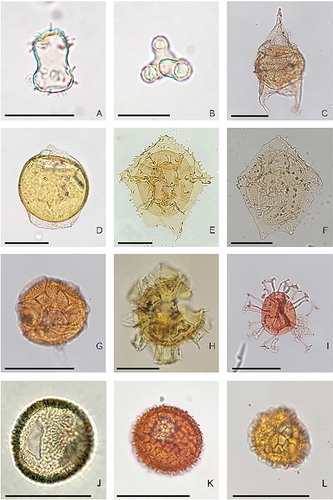
Earlier studies (e.g. Clowes Citation2009) have hinted at a significant turnover of dinoflagellate species within the Bortonian, but very little at the Porangan-Bortonian boundary itself. It is possible that the last appearance of Pyxidinopsis crassimurata s.s. may coincide approximately with the boundary, but this will require further corroboration.
Discussion
Morgans et al. (Citation2004) proposed that the base of the Bortonian Stage be recognised by the first appearance of abundant, large Globigerinatheka index with multiple apertures. The writers are unaware of any dissenting opinion, and have adopted this criterion herein, by placing the boundary at 11.2 m in the eastern section at Tahuokaretu Stream (recognising the possibility that more closely spaced sampling in future may lower the boundary by up to ∼2.5 m).
Whereas the range charts given in Hornibrook et al. (Citation1989, fig. 15 and 16 on p. 104–105 and Table 2(2) on p. 114) indicate first appearances of numerous foraminifera species at the Porangan-Bortonian boundary, our observations at Tahuokaretu Stream and elsewhere have not shown this pattern of coincident first appearances. Whether the other taxa sometimes do appear exactly at the same horizon (a literal interpretation of Hornibrook et al. Citation1989), or their first appearances are always staggered, as found in the present study, remains unknown at present.
Underlying the first appearance of Globigerinatheka index, Porangan foraminiferal assemblages throughout New Zealand very commonly include the species Elphidium saginatum (pers. obs.) The species is not ubiquitous, however: the absence from Porangan sections in the East Coast of North Island is not unusual. Elphidium saginatum is absent from one sample from the type locality at Te Uri Stream, from two samples from Tawanui section (), from one sample from Aropito section (all pers. obs.), and, as reported above, from one sample (U24/f1427) in the eastern section and another (U24/f1480) in the western section, at Tahuokaretu Stream.
Marine palynofloras of Porangan to earliest Bortonian age are insufficiently well-documented to provide further biostratigraphic resolution at present, but are the subject of on-going investigation.
Proposed new definition for the base of the Bortonian stage
It is proposed that the base of the New Zealand Bortonian Stage be placed at the first appearance of abundant, large specimens of Globigerinatheka index (Foraminiferida), at ∼11.2 m above the base of the eastern section at Tahuokaretu Stream, approximately 3 km east of Weber in Tararua District, and that previous definitions of this boundary be abandoned.
The proposed new reference section:
is near (∼16 km south-west of) the original Porangan type locality, Te Uri Stream, and occurs within the same formation (Wanstead Formation);
is easily accessed from Tahuokaretu Road, off Route 52;
contains proven, rich and diverse assemblages of foraminifera and dinoflagellates;
contains ostracods and abundant radiolarians and, possibly, other microfossil groups;
comprises several metres of section and is well-exposed both above and below the boundary; and
reveals no evidence for significant missing time or greensands that would suggest condensed intervals.
Although less well-known, the section at Tahuokaretu is a superior boundary reference section to that at Hampden Beach in most respects.
It is almost certain that calcareous nannofossils are present. Further investigation of this group and the radiolaria is suggested.
Tahuokaretu taxon range data
Download MS Excel (18.3 KB)Acknowledgements
The authors thank their GNS colleagues, Ian Raine, Percy Strong, Kyle Bland, Dominic Strogen, Roger Cooper and Lucia Roncaglia, for useful discussions and reviewing earlier drafts of this paper. Constructive reviews by James Crampton and R Ewan Fordyce improved the paper. Thanks are also extended to Ben Hines (Victoria University of Wellington) for field assistance, and to Roger Tremain, Henry Gard and Randall McDonnell for laboratory services and SEM photography (Henry Gard). Access to the site was readily provided by Steve Lewis of Mangatoitoi Farm.
Disclosure statement
No potential conflict of interest was reported by the authors.
Additional information
Funding
References
- Allan RS. 1933. On the system and stage names applied to subdivisions of the Tertiary strata in New Zealand. Transactions and Proceedings of the New Zealand Institute. 63(2):81–108.
- Berggren WA, Kent DV, Swisher CC, III, Aubry M.-P. 1995. A revised Cenozoic geochronology and chronostratigraphy. In Berggren WA, Kent DV, Swisher CC, III, Aubry M.-P., Hardenbol J, editors. Geochronology, time scales and global stratigraphic correlation. SEPM Special Publication No 54; p. 129–212.
- Cameron AA, Waghorn DB. 1985. Bortonian/Kaiatan foraminifera and calcareous nannofossils from Hampden Beach and McCulloch’s Bridge. In: Cooper RA, editor. Hornibrook Symposium, 1985, extended abstracts. New Zealand Geological Survey Record 9; p. 18–20.
- Clowes CD. 2009. Dinoflagellate taxonomy and biostratigraphy of the Mid- to Late Eocene and Early Oligocene of New Zealand. Unpublished PhD thesis. Victoria University of Wellington.
- Clowes CD, Bland KJ, Morgans HEG, Hines BR. 2016. Record of geological observations and sample collection from Late Cretaceous - early Miocene strata in southern Hawke's Bay, 04-08 April 2016. Lower Hutt, NZ: GNS Science. GNS Science internal report 2016/14: 1-49.
- Clowes CD, Wilson GJ. 2006. Some new species of Corrudinium Stover & Evitt 1978 (Dinophyceae) from the Eocene of New Zealand. New Zealand Journal of Geology and Geophysics. 49:399–408. doi: 10.1080/00288306.2006.9515176
- Cooper RA, editor. 2004. The New Zealand Geological Timescale. Institute of Geological and Nuclear Sciences Monograph. 22:1–284.
- Finlay HJ, Marwick J. 1940. The divisions of the Upper Cretaceous and Tertiary in New Zealand. Transactions of the Royal Society of New Zealand. 70:77–135.
- Finlay HJ, Marwick J. 1947. New divisions of the New Zealand Upper Cretaceous and Tertiary. New Zealand Journal of Science and Technology Series B. 28:228–236.
- Gradstein FM, Ogg JG, Schmitz MD, Ogg GM. 2012. The geological time scale 2012. Oxford, UK: Elsevier B.V.
- Hayward BW. 1986. A guide to paleoenvironmental assessment using New Zealand Cenozoic foraminiferal faunas. New Zealand Geological Survey Report PAL. 109:1–73.
- Hayward BW, Scott GH. 2013: Historical view of New Zealand foraminiferal studies. In Bowden AJ, Gregory FJ, Henderson AS, editors. 2013: landmarks in foraminiferal micropalaeontology: history and development. The Micropalaeontological Society, Special Publication, p. 271–283.
- Hollis CJ, Beu AG, Crampton JS, Crundwell MP, Morgans HEG, Raine JI, Jones CM, Boyes AF. 2010. Calibration of the New Zealand Cretaceous-Cenozoic timescale to GTS2004. Lower Hutt: GNS Science. GNS Science Report. 2010/43:1–20.
- Hornibrook NdB, Brazier RC, Strong CP. 1989. Manual of New Zealand Permian to Pleistocene foraminiferal biostratigraphy. New Zealand Geological Survey Paleontological Bulletin. 56:1–175.
- Morgans HEG, Beu AG, Cooper RA, Crouch EM, Hollis CJ, Jones CM, Raine JI, Strong CP, Wilson GJ, Wilson GS. 2004. Paleogene (Dannevirke, Arnold and Landon Series). In: Cooper, R.A., editors. 2004: the New Zealand Geological Timescale. Lower Hutt: Institute of Geological & Nuclear Sciences Limited. Institute of Geological & Nuclear Sciences monograph 22; p. 124–163.
- Morgans HEG. 2009. Late Paleocene to middle Eocene foraminiferal biostratigraphy of the Hampden Beach section, eastern South Island, New Zealand. New Zealand Journal of Geology and Geophysics. 52(4):273–320. doi: 10.1080/00288306.2009.9518460
- Morgans I. 2002. Tahuokaretu road. CHB Print, Waipukurau, 1-112.
- Morkhoven FPCMv, Berggren WA, Edwards AS. 1986. Cenozoic cosmopolitan deep-water benthic foraminifera. Bulletin des centres de recherches Exploration-Production Elf-Aquitaine. Mémoire. 11:1–421.
- Park J. 1918. The geology of the Oamaru district, North Otago (Eastern Otago Division). New Zealand Geological Survey Bulletin 20. 119 p.
- Raine JI, Beu AG, Boyes AF, Campbell HJ, Cooper RA, Crampton JS, Crundwell MP, Hollis CJ, Morgans HEG. 2015. New Zealand Geological Timescale NZGT 2015/1. New Zealand Journal of Geology and Geophysics. doi:10.1080/00288306.2015.1086391.
- Remane J, Bassett MG, Cowie JW, Gohrbrandt KH, Lane HR, Michelsen O, Wang N. 1996. Revised guidelines for the establishment of global chronostratigraphic standards by the International Commission on Stratigraphy (ICS). Episodes. 19(3):77–81.
- Thomson JA. 1916. On stage names applicable to the division of the Tertiary in New Zealand. Transactions of the New Zealand Institute. 48:28–40.
- Tjalsma RC, Lohmann GP. 1983. Paleocene-Eocene bathyal and abyssal benthic foraminifera from the Atlantic Ocean. Micropaleontology Special Publication Number. 4:90.
- Wilson GJ. 1982. Eocene and Oligocene dinoflagellate assemblages from the Oamaru area, North Otago. New Zealand Geological Survey Report PAL. 60:1–20. pl. 1–4.
- Wilson GJ. 1985. Dinoflagellate biostratigraphy of the Eocene Hampden section North Otago, New Zealand. New Zealand Geological Survey Record. 8:93–101.
- Wilson GJ. 1988. Paleocene and Eocene dinoflagellate cysts from Waipawa, Hawkes Bay, New Zealand. New Zealand Geological Survey Paleontological Bulletin. 57:1–96.
